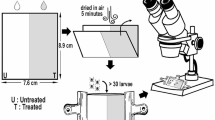Abstract
The use of insects for evaluating the virulence of microbial pathogens and for determining the efficacy of antimicrobial drugs is increasing. When larvae of the greater wax moth Galleria mellonella were incubated at 4 or 37°C for 24 h. prior to infection, they manifested increased resistance to infection by the yeast Candida albicans compared to larvae that had been pre-incubated for 24 h at 30°C. Incubation at 4 or 37°C led to an increase in haemocyte density and the expression of genes coding for gallerimycin, transferrin, an inducible metalloproteinase inhibitor (IMPI) and galiomicin. Peak expression of these genes was recorded at approximately 24 h after the commencement of the 4 or 37°C incubation. These results indicate that exposure of larvae to mild thermal shock conditions induces a protective cellular and humoral immune response mediated by increased numbers of haemocytes and elevated expression of antimicrobial peptides.
Similar content being viewed by others
Abbreviations
- AMP:
-
Anti-microbial peptide(s)
- IMPI:
-
Inducible metalloproteinase inhibitor
References
Vilmos P, Kurucz E. Insect immunity: evolutionary roots of the mammalian innate immune system. Immunol Lett 1998;62:59–66.
Kavanagh K, Reeves EP. Expoliting the potential of insects for the in vivo pathogenicity testing of microbial pathogens. FEMS Microbiol Rev 2004;28:101–12.
Scully LR, Bidochka M. Developing insect models for the study of current and emerging human pathogens. FEMS Microbiol Lett 2006;263:1–9.
Cotter G, Doyle S, Kavanagh K. Development of an insect model for the in vivo pathogenicity testing of yeasts. FEMS Immun Med Microbiol 2000;27:163–9.
Brennan M, Thomas DY, Whiteway M, Kavanagh K. Correlation between virulence of Candida albicans mutants in mice and Galleria mellonella larvae FEMS Immunol Med Microbiol 2002;34(2):153–7.
Reeves EP, Messina CGM, Doyle S, Kavanagh K. Correlation of gliotoxin production and virulence of aspergillus fumigatus in Galleria mellonella. Mycopathologia 2004; 158:73–9.
Boman HG, Hultmark D. Cell-free immunity in insects. Annu Rev Microbiol 1987;41:103–26.
Price CD, Ratcliffe NA. A reappraisal of insect haemocyte classification by the examination of blood from fifteen insect orders. Z Zellforsch Mikrosk Anat 1974;147:537–49.
Lehrer RI, Lichtenstein AK, Ganz T. Defensins: antimicrobial and cytotoxic peptides of mammalian cells. Annu Rev Immunol 1993;11:105–28.
Lehrer RI, Ganz T. Antimicrobial peptides in mammalian and insect host defense. Curr Opin Immunol 1999;11:23–7.
Tytler EM, Anantharamaiah GM, Walker DE, Mishra VK, Palgunachari MN, Segrest JP. Molecular basis for prokaryotic specificity of magainin induced lysis. Biochemistry 1995;34:4393–401.
Bergin D, Murphy L, Keenan J, Clynes M, Kavanagh K. Pre-exposure to yeast protects larvae of Galleria mellonella from a subsequent lethal infection by Candida albicans and is mediated by the increased expression of antimicrobial peptides. Microbes Infect 2006;8:2105–12.
Bethencort R, Asha H, Dearolf C, Tony Y. Hemolymph-dependent and independent responses in drosophila immune tissue. J Cell Biochem 2004;92:849–63.
Loetti MV, Burroni NE, Schweigmann N, de Garin A. Effect of thermal conditions on the pre-imaginal biology of␣Culex apicinus (Phillipi, 1865) (Diptera: Culicidae). J␣Vector Ecol 2007;32:106–11.
Bergin D, Brennan M, Kavanagh K. Fluctuations in haemocyte density and microbial load may be used as indicators of fungal pathogenicity in larvae of Galleria mellonella. Microbes Infect 2003;5(15):1389–95.
Lemaitre B, Reichhart JM, Hoffmann JA. Drosophila host defense: differential induction of antimicrobial peptide genes after infection by various classes of microorganisms. Proc Natl Acad Sci U S A 1997;94(26):14614–9.
Matha V, Mracek Z. Changes in haemocyte counts in Galleria mellonella (L) (Lepidoptera: Galleriidae) larvae infected with Steinernema sp. (Nematoda: steinernematidae). Nematol 1984;30:86–9.
Morton D, Dunphy G, Chadwick J. Reactions of haemocytes of immune and non-immune Galleria mellonella larvae to Proteus mirabilis. Develop Comparat Immunol 1987;11:47–55.
Lee YS, Yun EK, Jang WS, Kim I, Lee JH, Park SY, Ryu KS, Seo SJ, Kim CH, Lee IH. Purification, cDNA cloning and expression of an insect defensin from the great wax moth, Galleria mellonella. Insect Mol Biol 2004;13(1):65–72.
Schuhmann B, Seitz V, Vilcinskas A, Podsiadlowski L. Cloning and expression of gallerimycin, an antifungal peptide expressed in immune response of greater wax moth larvae, Galleria mellonella. Arch Insect Biochem Physiol 2003;53(3):125–33.
Yoshiga T, Georgieva T, Dunkov BC, Harizanova N, Ralchev K, Law JH. Drosophila melanogaster transferrin. Cloning, deduced protein sequence, expression during the life cycle, gene localization and up-regulation on bacterial infection. Eur J Biochem 1999;260(2):414–20.
Wedde M, Weise C, Kopacek P, Franke P, Vilcinskas A. Purification and characterization of an inducible metalloprotease inhibitor from the hemolymph of greater wax moth larvae, Galleria mellonella. Eur J Biochem 1998;255 (3):535–43.
Clermont A, Wedde M, Seitz V, Podsiadlowski L, Lenze D, Hummel M, Vilcinskas A. Cloning and expression of an inhibitor of microbial metalloproteinases from insects contributing to innate immunity. Biochem J 2004;382(1): 315–22.
Jander G, Rahme L, Ausbel F. Positive correlation between virulence of Pseudomonas aeruginosa mutants in mice and insects. J Bacteriol 2000;182:3843–5.
Mylonakis E, Moreno R, El Kohoury J, Idnurm A, Heitmann S, Calderwood S, Ausbel F, Diener A. Galleria mellonella as a model system to study Cryptococcus neoformans pathogenesis Infect. Immun 2005;73:3842–50.
Hamamoto H, Kurokawa K, Kaito C, Kamura K, Manitra Razanajatovo I, Kusuhara H, Santa T, Sekimizu K. Quantitative evaluation of the therapeutic effects of antibiotics using silkworms infected with human pathogenic microorganisms. Antimicrob Agent Chemother 2004;48: 774–9.
Ratcliffe N. Invertebrate immunity - a primer for the non-specialist. Immunol Lett 1985;10:253–70.
Lowenberger C. Innate response of Aedes aegyptii. Insect Biochem Mol Biol 2001;31:219–29.
Salzet M. Vertebrate innate immunity resembles a mosaic of invertebrate immune responses. Trends Immunol 2001;22:285–8.
Wojda I, Jakubowicz T. Humoral immune response upon mild heat shock conditions in Galleria mellonella larvae. J.␣Insect Physiol 2007; (PMID 17631308).
Acknowledgements
This work was supported by funding from the Higher Education Authority of Ireland through the Programme for Research in Third Level Institutes III (2002–2007).
Author information
Authors and Affiliations
Corresponding author
Rights and permissions
About this article
Cite this article
Mowlds, P., Kavanagh, K. Effect of pre-incubation temperature on susceptibility of Galleria mellonella larvae to infection by Candida albicans . Mycopathologia 165, 5–12 (2008). https://doi.org/10.1007/s11046-007-9069-9
Received:
Accepted:
Published:
Issue Date:
DOI: https://doi.org/10.1007/s11046-007-9069-9




